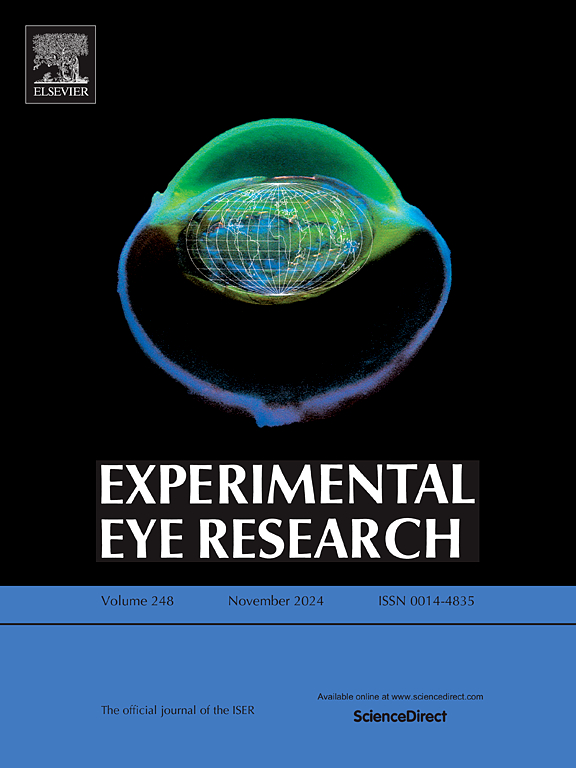使用 SS-OCT 成像评估大面积脉络膜高透射缺陷的持续性。
IF 3
2区 医学
Q1 OPHTHALMOLOGY
引用次数: 0
摘要
在老年性黄斑变性(AMD)中,大面积脉络膜高透射缺损(hyperTDs)在正面光学相干断层扫描(OCT)图像上被识别为最大线性尺寸(GLD)至少为 250 μm 的明亮病变。这些脉络膜超视网膜病变源于视网膜色素上皮(RPE)的局灶性衰减或缺失。我们以前曾报道过,一旦形成大的超视网膜病变,它们很可能会持续存在,而较小的病变则更有可能是一过性的。由于它们的相对持久性,这些大的持续性脉络膜超TD是中期AMD发展到晚期萎缩性AMD的一个不归点。此外,在研究可延缓疾病从中级 AMD 向晚期萎缩性 AMD 进展的疗法时,这些大面积脉络膜超TD 的出现可作为临床试验的终点。为了证实这些大面积脉络膜过度TD的持续性,我们研究了正在进行的前瞻性扫源OCT(SS-OCT)自然史研究中入选的AMD眼的独立数据集,以确定它们的总体持续性。我们共发现了 202 只患有大脉络膜超视网膜病变的眼睛,其中包含 1725 个超视网膜病变,平均跟踪观察 46.6 个月。我们发现,在这 1725 个大面积脉络膜高TD中,有 1718 个(99.6%)持续存在,只有 7 个(0.4%)不持续存在。在 6 只眼睛中的 7 个非持续性大型超远视中,基线时的平均 GLD 为 385 μm。在首次发现时大小在 250-300 μm 之间的大型超视密度病变中,只有一个不是持续性的,其基线 GLD 为 283 μm。在 6 个非持续性超视密度病变中,由于沿视网膜色素上皮(RPE)和在超视密度病变所在区域的视网膜上积累了超反射物质,因此失去了可检测到的大型超视密度病变。这种高反射物质被认为是 RPE 细胞迁移和聚集到这个病灶区域的结果,由于 RPE 的衰减或丢失,脉络膜超视密度出现在这个病灶区域。本文章由计算机程序翻译,如有差异,请以英文原文为准。
Evaluating the persistence of large choroidal hypertransmission defects using SS-OCT imaging
In age-related macular degeneration (AMD), large choroidal hypertransmission defects (hyperTDs) are identified on en face optical coherence tomography (OCT) images as bright lesions measuring at least 250 μm in greatest linear dimension (GLD). These choroidal hyperTDs arise from focal attenuation or loss of the retinal pigment epithelium (RPE). We previously reported that once large hyperTDs formed, they were likely to persist compared with smaller lesions that were more likely to be transient. Due to their relative persistence, these large persistent choroidal hyperTDs are a point-of-no-return in the progression of intermediate AMD to the late stage of atrophic AMD. Moreover, the onset of these large choroidal hyperTDs can serve as a clinical trial endpoint when studying therapies that might slow disease progression from intermediate AMD to late atrophic AMD. To confirm the persistence of these large choroidal hyperTDs, we studied an independent dataset of AMD eyes enrolled in an ongoing prospective swept-source OCT (SS-OCT) natural history study to determine their overall persistence. We identified a total of 202 eyes with large choroidal hyperTDs containing 1725 hyperTDs followed for an average of 46.6 months. Of the 1725 large hyperTDs, we found that 1718 (99.6%) persisted while only 7 hyperTDs (0.4%) were non-persistent. Of the 7 non-persistent large hyperTDs in 6 eyes, their average GLD at baseline was 385 μm. Of the large hyperTDs ranging in size between 250 and 300 μm when first detected, only one was not persistent with a baseline GLD of 283 μm. In 6 of the non-persistent hyperTDs, the loss of a detectable large hyperTD was due to the accumulation of hyperreflective material along the retinal pigment epithelium (RPE) and in the retina over the area where the hyperTD was located. This hyperreflective material is thought to represent the migration and aggregation of RPE cells into this focal region where the choroidal hyperTD arose due to attenuated or lost RPE.
求助全文
通过发布文献求助,成功后即可免费获取论文全文。
去求助
来源期刊

Experimental eye research
医学-眼科学
CiteScore
6.80
自引率
5.90%
发文量
323
审稿时长
66 days
期刊介绍:
The primary goal of Experimental Eye Research is to publish original research papers on all aspects of experimental biology of the eye and ocular tissues that seek to define the mechanisms of normal function and/or disease. Studies of ocular tissues that encompass the disciplines of cell biology, developmental biology, genetics, molecular biology, physiology, biochemistry, biophysics, immunology or microbiology are most welcomed. Manuscripts that are purely clinical or in a surgical area of ophthalmology are not appropriate for submission to Experimental Eye Research and if received will be returned without review.
 求助内容:
求助内容: 应助结果提醒方式:
应助结果提醒方式:


